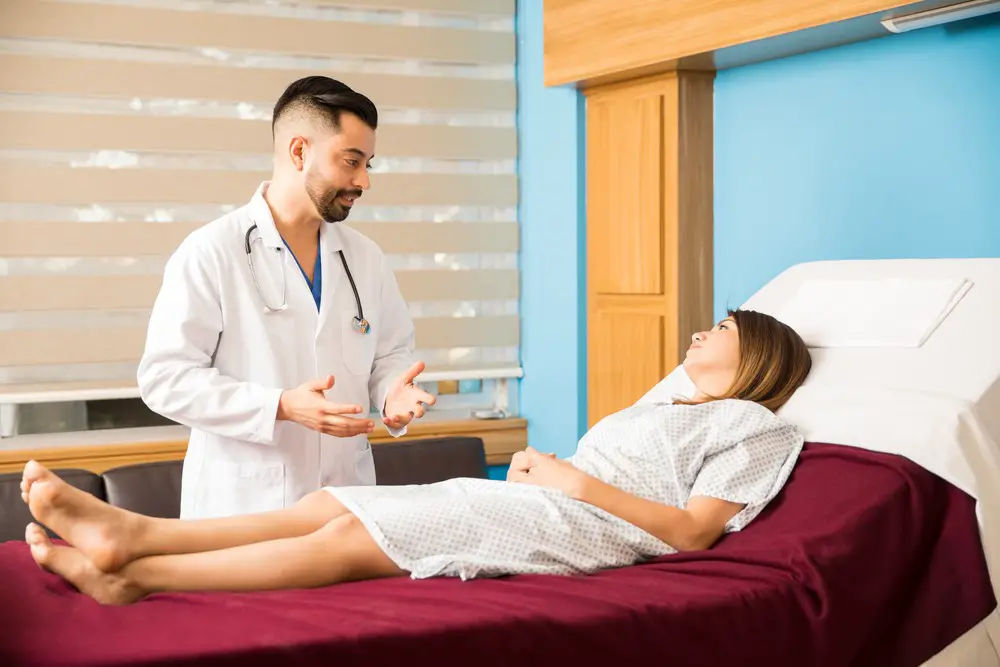As a BetterHelp affiliate, we receive compensation from BetterHelp if you purchase products or services through the links provided
Undergoing cervical neck surgery can be a life-changing experience, and the recovery process plays a crucial role in regaining mobility and reducing pain. One of the most important aspects of post-surgery recovery is learning to sleep effectively while promoting healing. Proper sleep positioning and techniques can make a significant difference in supporting a smooth and efficient healing process.
Cervical neck surgery can affect an individual’s comfort levels, and adjusting to a new way of sleeping can be challenging. Ensuring the right balance between comfort and essential support during sleep is vital to prevent complications and promote a speedy recovery. This article provides valuable insights and tips for optimal sleep after cervical neck surgery, including sleeping positions, managing pain, and gradually resuming daily activities.
Key Takeaways
- Proper sleep positioning is crucial for post-surgery recovery and healing
- Managing pain and swelling during sleep can improve comfort and overall recovery
- Gradually resuming daily activities is important for avoiding complications and risks

Preparing for Cervical Neck Surgery
Understanding the Procedure
Cervical neck surgery addresses various neck issues, such as relieving pain, improving spinal stability, or treating spinal cord compression. Before surgery, patients need to understand the type of procedure they will undergo and the potential risks and benefits involved. They should discuss their concerns and expectations with their surgeon.
Spine Surgery Types
There are several types of cervical spine surgery, including:
- Anterior cervical discectomy and fusion (ACDF): This surgery involves removing a damaged intervertebral disc through an incision in the front of the neck and fusing the adjacent vertebrae. This procedure helps alleviate pressure on the spinal nerves and stabilize the cervical spine.
- Posterior cervical discectomy: In this procedure, surgeons approach the neck from the back and remove the damaged disc or bone spurs compressing the spinal cord or nerves. This surgery is less common than ACDF as it may not provide as much stability to the spine.
- Foraminotomy: This type of surgery is performed to enlarge the space through which the spinal nerves exit from the spinal cord. By removing any bone spurs or other obstructions in this space, nerve compression can be reduced, and neck pain can be alleviated.
- Cervical arthroplasty: This procedure involves replacing the damaged cervical disc with an artificial one to maintain motion in the neck. It is an alternative to fusion surgery, aiming to preserve the natural range of motion in the cervical spine.
Knowing the specific type of surgery and its implications will help patients make informed decisions and prepare adequately for their recovery.

Post-Surgery Care and Recovery
The First Few Weeks
After cervical neck surgery, patients should focus on proper care and recovery during the initial weeks. Managing pain and discomfort is crucial in this phase. The surgical site may be tender, so keeping the incision clean and dry is essential to prevent infection. Patients should follow their doctor’s instructions for wound care closely.
In the first few weeks, patients may experience difficulties with daily activities. They should take short, gentle walks to promote blood circulation and gradually increase the distance as they regain strength. While at home, it’s crucial to maintain a comfortable and supportive sleeping position. Patients can use an adjustable bed or a cervical pillow to help with this.
Additionally, patients should avoid strenuous activities, excessive bending, and heavy lifting in these initial weeks to protect the surgical site and facilitate proper healing. They must adhere to the prescribed pain management plan and contact their doctor if they encounter any concerns or changes in their condition.
Long-term Recovery
As weeks turn into months, patients will continue to notice improvements in their recovery process. Physical therapy may be recommended to help restore flexibility, strength, and range of motion in the neck area. Patients must follow through with their physical therapy program and consistently perform prescribed exercises to achieve optimal results.
Monitoring the surgical site is still essential during long-term recovery. Patients should be aware of any redness, swelling, or discharge and consult their doctor if any complications arise. Furthermore, they must follow their doctor’s guidelines regarding activity restrictions, aiming to resume normal activities as advised gradually.
To ensure a successful long-term recovery, patients should maintain a healthy lifestyle, incorporating regular exercise, proper nutrition, and stress management techniques. This will aid their healing process, contribute to overall well-being, and prevent future neck problems.
Sleeping Positions and Techniques
Pillows and Support for Neck
The right pillow is essential for a comfortable sleep after cervical neck surgery. A supportive cervical pillow can help maintain proper alignment and reduce neck pain. These pillows have a contoured design, providing optimal head and neck support. Choosing a pillow with the appropriate height and firmness is essential based on personal preference and comfort.
Another option is a foam roll cushion, which can be placed under the neck for additional support. This helps maintain good posture while sleeping and relieves pressure on the spine. Doctors sometimes recommend using a hard or soft collar to support and restrict neck movements during sleep.
Finding a Comfortable Position
Sleeping positions greatly impact the comfort and recovery after cervical neck surgery. The most recommended position is sleeping on the back with a slight incline. This can be achieved by using a wedge pillow or an adjustable bed. This position helps reduce swelling and facilitates proper spinal alignment.
A log roll technique can make it easier for those who prefer sleeping on their side. The log roll involves moving the entire body as a single unit, which helps maintain spinal alignment. A cushion between the knees can also support the lower back and hips.
A recliner can also be an alternative for those who find sleeping in a flat position difficult. However, it is important to maintain good posture even when using a recliner to prevent any strain on the neck muscles.
Remember to follow the doctor’s recommendations and prioritize comfort, supporting proper sleep during recovery.
Managing Pain and Swelling
Ice and Heat Therapy
Patients can utilize ice and heat therapy to manage pain and swelling after cervical neck surgery. Applying an ice pack to the affected area for 15-20 minutes several times daily can help reduce swelling. A cloth barrier between the ice pack and the skin is important to prevent frostbite. After 48 hours, patients can start alternating ice and heat. Warm compresses can alleviate discomfort and promote blood flow to the area, speeding up the healing process.
Medication
To manage pain and discomfort after surgery, various medications may be prescribed. Over-the-counter pain relievers like acetaminophen can alleviate fever and mild pain. Patients should always follow their healthcare provider’s instructions for pain medication dosages and frequency.
Sometimes, the healthcare provider may prescribe stronger pain medications or muscle relaxants for a limited time to alleviate severe pain or discomfort. Communicating any side effects, like numbness or tingling, with the healthcare provider promptly is essential.
Nonsteroidal anti-inflammatory drugs (NSAIDs) may be prescribed for inflammation and swelling. These medications can help reduce swelling and alleviate pain, but patients should be cautious due to potential risks such as gastrointestinal bleeding.
Here is a summary of the mentioned pain-relief approaches:
| Method | Benefits | Considerations |
|---|---|---|
| Ice and Heat Therapy | Reduces swelling, alleviates discomfort, speeds up healing | Follow proper technique, alternate after 48 hours |
| Acetaminophen | Alleviates fever and mild pain | Follow the healthcare provider’s instructions |
| Prescription Pain Medications | Alleviates severe pain | Monitor side effects, use for a limited duration |
| NSAIDs | Reduces inflammation, alleviates pain | The potential risk of gastrointestinal bleeding |
Remember always to follow your healthcare provider’s advice and recommendations regarding pain management and swelling reduction after cervical neck surgery.
Physical Activity and Exercise
Returning to Daily Activities
After cervical neck surgery, it’s crucial to return to daily activities gradually. Patients should start with light activities such as walking. Walking not only improves blood flow but also prevents complications like blood clots. Patients may need assistance or support initially, but they should eventually increase their walking distance without help.
Regarding sitting, patients should avoid prolonged periods of sitting during the first few weeks. When sitting, it’s essential to maintain good posture and use ergonomically designed supports to alleviate pressure on the neck. Adjusting workstations may be necessary for optimal ergonomics.
Driving should be avoided or limited until a healthcare provider approves it. Neck movements may be restricted, affecting the patient’s ability to drive safely. The recovery period varies, but it typically takes a few weeks before a patient can safely resume driving.
Rehabilitation Exercises
Rehabilitation exercises play a vital role in restoring normal neck function. A healthcare provider or physical therapist will recommend an appropriate exercise program tailored to the patient’s needs. Some common exercises include:
- Neck stretches: Gently stretch the neck muscles by tilting the head forward, backward, and side to side. Hold each position for 5-10 seconds.
- Shoulder rolls: Slowly roll the shoulders in a circular motion to improve mobility and release tension.
- Neck extensions: Tilt the chin upward, stretch the neck muscles, and return to the starting position.
Patients should never force their necks into uncomfortable positions or engage in lifting heavy objects during the initial recovery phase. As healing progresses, light resistance exercises may be introduced, but always follow the guidance of a healthcare or rehabilitation specialist.
Resuming physical activity and sports should also be done with caution. Return to high-impact activities only after receiving a healthcare provider’s clearance, and gradually increase the intensity and duration of exercise to prevent injury. The goal is to regain a healthy and active lifestyle while protecting the healing cervical spine.
Avoiding Complications and Risks
Monitoring for Infections
After cervical neck surgery, monitoring the surgical site for any signs of infection is essential. Patients should regularly check their sutures and surrounding areas for symptoms such as redness, swelling, or an unpleasant odor. They should contact their healthcare provider immediately if any of these signs are detected.
To minimize the risk of infection, patients are advised to keep the wound clean and dry. One should follow the surgeon’s instructions about how to care for the incision site, including the frequency and method of cleaning and dressing the wound.
Preventing Blood Clots
Blood clots can pose a dangerous risk following surgery. To help prevent the formation of blood clots, patients should avoid activities that may cause excessive twisting or bending of the neck. They should also avoid smoking, as it may increase clotting and slow the healing process.
To further reduce the risk of blood clots, patients can follow these tips:
- Move around as soon as possible after surgery, as the surgeon recommends.
- Wear compression stockings if prescribed by the healthcare provider.
- Stay hydrated by drinking plenty of water.
It is crucial to be cognizant of any symptoms that may indicate the presence of a blood clot, such as:
- Swelling, warmth, or tightness in one leg.
- Difficulty breathing or shortness of breath.
- Chest pain that worsens with deep breaths or coughing.
If any of these symptoms occur, it is critical to seek medical attention immediately.
Additional Tips for Recovery
Showering and Bathing
Keeping the incision area clean and dry after cervical neck surgery is essential. Patients should wait for the physician’s approval before showering or bathing. Generally, they can start showering 48 to 72 hours after the surgery, avoiding direct water pressure on the incision site. Having a family member or friend nearby for assistance during the first few showers is best, as the patient may feel lightheaded or unsteady.
Diet and Nutrition
A healthy diet is crucial for a smooth recovery. Patients may experience a sore throat or difficulty swallowing immediately after surgery. It is recommended to consume soft foods and liquids to alleviate discomfort. Some examples of mild foods include:
- Yogurt
- Mashed potatoes
- Soups
- Smoothies
Staying hydrated by drinking water or other clear liquids is also essential. It can help prevent constipation, a common side effect of pain medications after neck surgery.
Incorporating a high-fiber diet can aid digestion and further prevent constipation. Some high-fiber foods are:
- Fruits
- Vegetables
- Whole grains
- Legumes
Listen to your body’s needs and consult your physician if you have concerns about your diet.
Rest and proper care after cervical neck surgery play a significant role in recovery. Using the appropriate pillows to support the neck and ensure proper alignment can also aid healing. By following these additional tips and guidelines your healthcare team provides, you can work towards a successful recovery.
Managing Overall Health
Mental and Emotional Well-being
After cervical neck surgery, it is essential to prioritize mental and emotional well-being. Stress and anxiety can hinder healing, so finding healthy ways to cope with emotions is crucial. Patients should consider engaging in relaxation techniques such as meditation, deep breathing exercises, or listening to calming music. Talking about their feelings with friends, family, or a therapist can also be beneficial.
Staying Informed
Being knowledgeable about the recovery process is vital for overall health. Patients should learn as much as possible about their cervical spine surgery, including its benefits and potential risks. They can ask their doctor or healthcare provider specific questions about the procedure, post-operative care, and expected outcomes. Staying informed will allow patients to identify any issues early on and take appropriate action to address them. Participating in physical therapy sessions with a specialist can help improve mobility and strengthen the affected area, aiding overall recovery.
Communicating with Your Doctor
Regular communication with the doctor or healthcare provider is paramount for successful recovery. Patients should report any changes in their condition, such as increased pain, weakness, or mobility issues. Discussing concerns and asking questions about the recovery process enables the doctor to provide proper guidance and adjust the treatment plan if necessary. If complications arise, such as nerves or spinal cord issues, immediate attention from the specialist is crucial to prevent further damage and ensure a smoother recovery process.
Frequently Asked Questions
What is the best pillow for post-surgery?
After cervical neck surgery, it is essential to use a pillow that provides sufficient support and maintains the neck in a neutral alignment. A cervical pillow, also known as a neck pillow, is recommended as it features a contoured shape that cradles the neck comfortably. These pillows are available in various materials, such as memory foam or water-filled, and can be adjusted to suit individual preferences.
What is the C5-C6-C7 recovery time?
Recovery time following cervical neck surgery varies depending on the individual and the specific procedure. Generally, patients recovering from C5-C6-C7 surgery may require four to six weeks for the initial healing phase. However, complete healing, strengthening, and return to normal activities can take several months.
Post-cervical fusion precautions
Post-surgery, it is crucial to take certain precautions to ensure a smooth recovery. Some recommendations include:
- Avoid lifting heavy objects
- Refrain from bending or twisting the neck excessively
- Restrict activities that may cause strain on the neck
- Follow physical therapy routines as prescribed by your healthcare professional
Nerve healing duration
Nerve healing duration depends on various factors, such as the severity of the injury and the individual’s overall health. Generally, nerves may take several months or even a year to heal fully. Following your healthcare professional’s advice is essential during this period, attending follow-up appointments and engaging in prescribed physical therapy exercises.
What are the ACDF surgery restrictions?
Patients recovering from anterior cervical discectomy and fusion (ACDF) surgery should adhere to certain restrictions to prevent complications and promote healing:
- Avoid strenuous activity or exercise for four to six weeks
- Refrain from lifting anything heavier than 10 pounds during the initial recovery phase
- Gradually introduce light activities in consultation with your healthcare professional
- Talk to your surgeon before driving or returning to work, as recommendations may vary based on individual circumstances
What are some tips for handling hand numbness?
Hand numbness following cervical neck surgery may gradually improve as the nerves heal. However, while recovering, patients can:
- Perform prescribed range-of-motion and strengthening exercises as advised by a physical therapist
- Use heat or cold therapy to manage pain and inflammation
- Consult a healthcare professional to discuss additional treatment options if needed
- How to Transform a Home’s Patio Space into a Relaxing Space - March 23, 2025
- 5 Strategies to Use a Cell Phone to Help Manage Your Stress - March 23, 2025
- 4 Ways to Use Measurements to Create a Relaxing Sleep Space - March 23, 2025
This site contains affiliate links to products. We will receive a commission for purchases made through these links.



